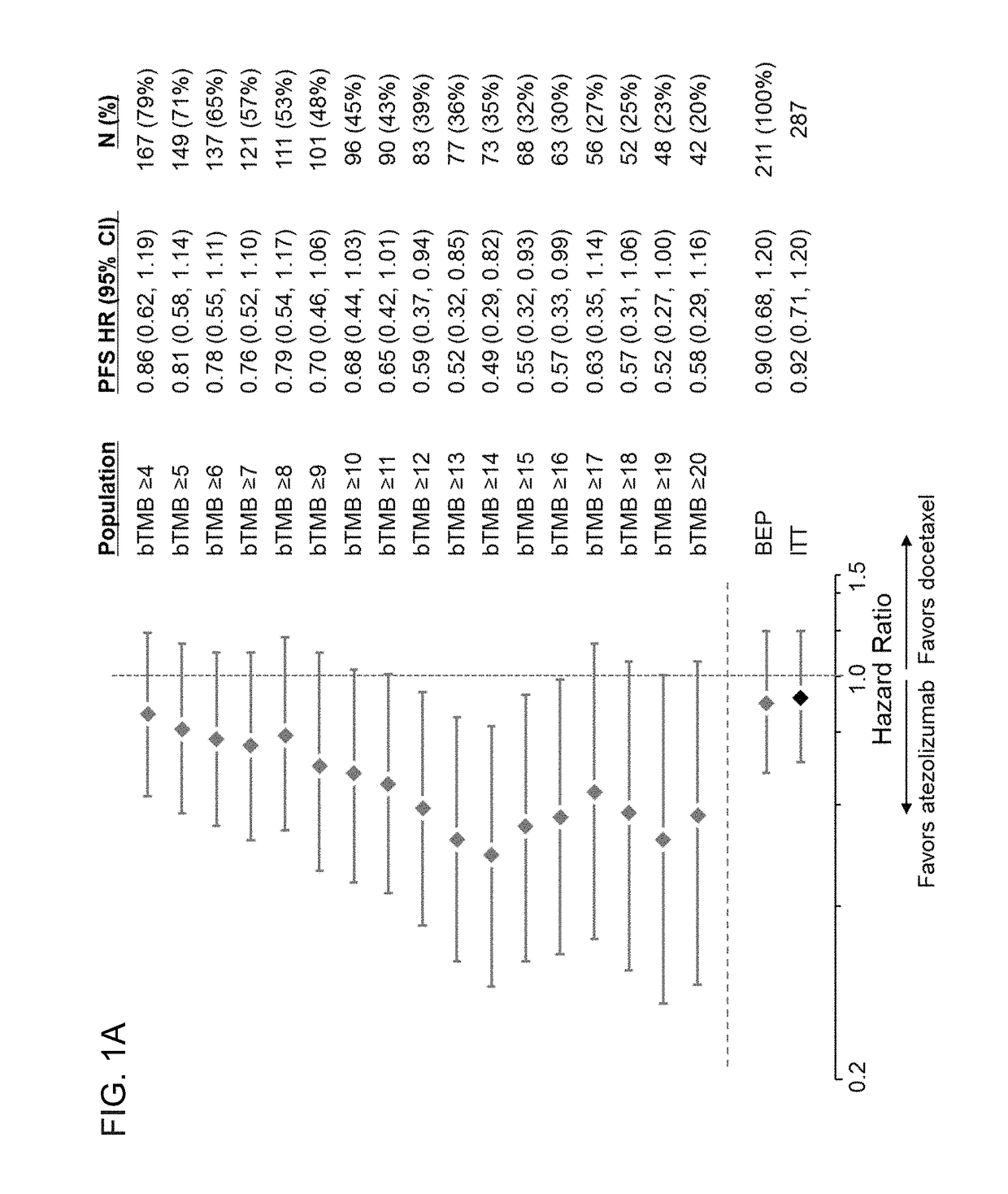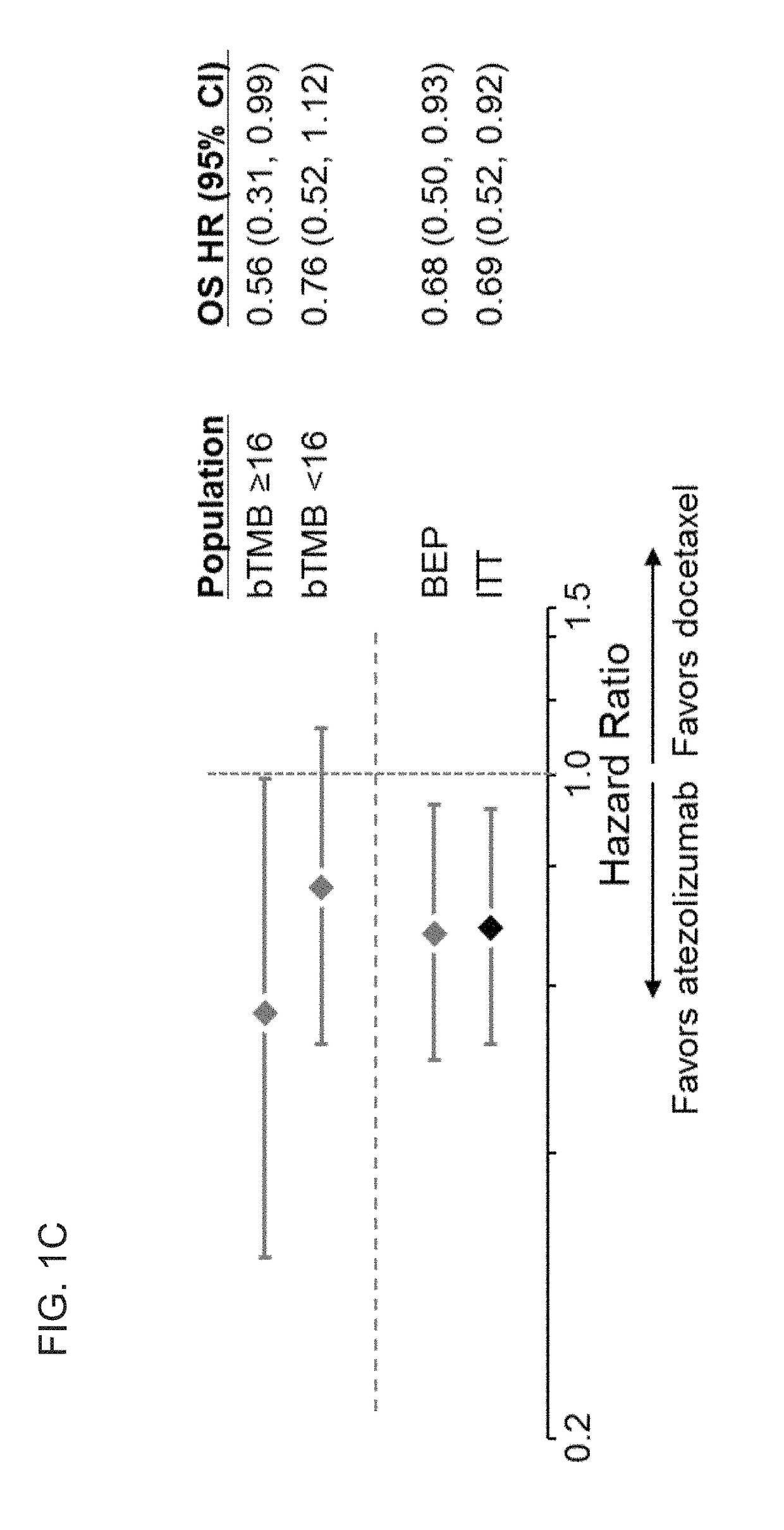Therapeutic and diagnostic methods for cancer
- Summary
- Abstract
- Description
- Claims
- Application Information
AI Technical Summary
Benefits of technology
Problems solved by technology
Method used
Image
Examples
example 1
[0521]A blood-based assay was used to evaluate the association between clinical response to treatment with atezolizumab (MPDL3280A) and blood tumor mutational burden (bTMB) score in patients with non-small cell lung cancer (NSCLC) enrolled in two clinical trials, a phase II clinical trial, POPLAR (Clinical Trial ID No.: NCT01903993), and a phase III clinical trial, OAK (Clinical Trial ID No.: NCT02008227), in which atezolizumab was administered as a monotherapy.
[0522]Study Design
[0523]Pre-treatment blood samples from patients with NSCLC who were enrolled in the POPLAR and / or the OAK studies, in which atezolizumab was administered as a monotherapy, were evaluated for bTMB score and / or maximum somatic allele frequency (MSAF).
[0524]The POPLAR (Clinical Trial ID No.: NCT01903993) patient population evaluated for bTMB score consisted of 273 patients. Patients were eligible for enrollment in the POPLAR study if they had locally advanced or metastatic (e.g., stage IIIB, stage IV, or recurr...
example 2
of the Association Between bTMB Score and Clinical Response of Patients Having NSCLC to Treatment with Atezolizumab
[0565]To evaluate whether a bTMB score can be used as a predictive biomarker of patient response to atezolizumab treatment, bTMB scores were assessed in pre-treatment blood samples obtained from patients in the POPLAR or OAK trials as described in Example 1. The overall survival (OS) and progression-free survival (PFS) from the POPLAR and OAK trials were observed in patients who were diagnostic positive (Dx+) based on bTMB scores at, or above, reference scores between ≥4 to ≥20 and ≥4 to ≥26, respectively (FIGS. 1A, 1B, 2A, and 2B). PFS and OS benefit were observed at all bTMB score cut-offs between ≥10 and ≥20 in POPLAR (e.g., between ≥12 and ≥20) (FIGS. 1A and 1B). Dx+ patients with a bTMB score greater than, or equal to, a reference bTMB score of 18 were found to derive a greater PFS benefit from atezolizumab treatment than diagnostic negative (Dx−) patients in both ...
example 3
ndependent of PD-L1 IHC and Histology
[0577]The clinical characteristics of the bTMB subgroups in OAK are shown in Tables 10 and 11. Within the OAK BEP, positive bTMB status (≥16) was associated with smoking (P=1.3e−10), consistent with heavy mutagen exposure, SLD of target lesions at baseline (P=4.8e−08), number of metastatic sites (P=0.0055), and PD-L1 expression (TC1 / 2 / 3 or IC1 / 2 / 3 (P=0.0062) (Table 10). Baseline characteristics were balanced between treatment arms above the bTMB≥16 cut-point (Table 11). Mean bTMB value in patients with non-squamous histologies was 11.22 (95% CI: 10.09, 12.36) and 12.4 (95% CI: 11, 13.8) in those with squamous histology (FIG. 10).
TABLE 10Characteristics of the bTMB ≥16 Subgroup in the OAK StudyAtezolizumab Docetaxel P (N = 77)(N = 81)valueMedian age (range), years 62 (44, 78) 63 (41, 79)0.3Race, n (%)0.52Asian10 (13%)12 (15%)Other10 (13%)6 (7%)White57 (74%)63 (78%)Male, n (%)55 (71%)60 (74%)0.72Tumor histology, n (%)1Non-squamous50 (65%)53 (65%)Sq...
PUM
| Property | Measurement | Unit |
|---|---|---|
| Fraction | aaaaa | aaaaa |
| Fraction | aaaaa | aaaaa |
| Fraction | aaaaa | aaaaa |
Abstract
Description
Claims
Application Information
 Login to View More
Login to View More - R&D
- Intellectual Property
- Life Sciences
- Materials
- Tech Scout
- Unparalleled Data Quality
- Higher Quality Content
- 60% Fewer Hallucinations
Browse by: Latest US Patents, China's latest patents, Technical Efficacy Thesaurus, Application Domain, Technology Topic, Popular Technical Reports.
© 2025 PatSnap. All rights reserved.Legal|Privacy policy|Modern Slavery Act Transparency Statement|Sitemap|About US| Contact US: help@patsnap.com



